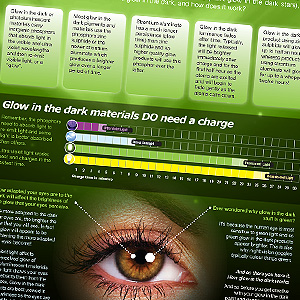
Have you ever wondered how those cool glow-in-the-dark toys and decorations manage to light up in the dark? It’s all thanks to fascinating materials that absorb light and release it slowly over time. This article delves into the science behind glow-in-the-dark materials, exploring the pigments responsible for their luminescence and how factors like sunlight exposure can affect their longevity. We’ll also discuss how to recharge these materials and keep them glowing brightly.
This comprehensive guide will cover the types of glow-in-the-dark pigments used, explain the scientific process behind phosphorescence, analyze the impact of light exposure on their effectiveness, and provide tips on maximizing their lifespan.
Glow-in-the-Dark Pigments
Glow-in-the-dark materials owe their magic to specialized pigments known as phosphorescent pigments. These pigments are carefully engineered to absorb light energy and store it within their molecular structure. Unlike fluorescent pigments that emit light immediately after absorbing it, phosphorescent pigments release the stored energy gradually over time, creating a captivating glow in the dark.
There are various types of phosphorescent pigments available, each with unique properties and applications. Some common examples include zinc sulfide, strontium aluminate, and europium-activated yttrium aluminum garnet (YAG). These pigments come in different colors, allowing for a wide range of glowing effects from vibrant greens and blues to subtle yellows and oranges.
The choice of pigment depends on the desired intensity, color, and duration of the glow. For instance, strontium aluminate is known for its long-lasting glow, making it ideal for applications requiring extended illumination.
Phosphorescence Explained
Phosphorescence is a fascinating phenomenon that involves the delayed emission of light after absorbing energy. When a phosphorescent material absorbs light, its electrons get excited to higher energy levels. These excited electrons are unstable and eventually return to their ground state, releasing the absorbed energy as photons – tiny packets of light.
The key difference between fluorescence and phosphorescence lies in the time it takes for this light emission to occur. Fluorescence is an immediate process, with light emitted almost instantly after absorbing energy. In contrast, phosphorescence involves a longer delay, with the light emission continuing for several minutes or even hours after the initial light source is removed.
This delayed emission is due to the fact that phosphorescent materials have “trapped” electrons in their excited state. These trapped electrons take longer to return to their ground state, resulting in a prolonged glow.
Sunlight and Light Exposure
While glow-in-the-dark materials are designed to be durable, they can be susceptible to fading over time, especially when exposed to strong light sources like sunlight.
Sunlight contains a wide spectrum of wavelengths, including ultraviolet (UV) radiation, which can damage the molecular structure of phosphorescent pigments. Prolonged UV exposure can break down the chemical bonds responsible for storing and releasing light energy, leading to a gradual decrease in the material’s glow intensity.
Similarly, other strong light sources like fluorescent lights or halogen bulbs can also contribute to fading over time.
Fade Over Time
The rate at which glow-in-the-dark materials fade depends on several factors, including the type of pigment used, the intensity and duration of light exposure, and the material’s overall quality. Some pigments are more resistant to fading than others, while higher-quality materials tend to have a longer lifespan.
It’s important to note that even with proper care, glow-in-the-dark wear out over time. This is simply a natural process due to the constant absorption and release of light energy. However, by minimizing exposure to strong light sources and following recommended storage practices, you can help prolong the life of your glow-in-the-dark items.
Recharging Glow-in-the-Dark Materials
Fortunately, most glow-in-the-dark materials can be recharged in darkness, restoring their luminescence. When exposed to light, these pigments absorb energy and store it within their molecular structure. This stored energy is then gradually released as light when the material is placed in darkness.
To recharge your glow-in-the-dark items, simply expose them to a bright light source for a few minutes. You can use natural sunlight, artificial light bulbs, or even a flashlight. The longer they are exposed to light, the brighter their glow will be when it’s dark.
Conclusion
Glow-in-the-dark materials offer a captivating and versatile way to add a touch of magic to our world. Understanding how these materials work and the factors that can affect their longevity allows us to appreciate their wonder even more. By minimizing exposure to strong light sources and recharging them regularly, we can enjoy the mesmerizing glow of these fascinating materials for years to come.
